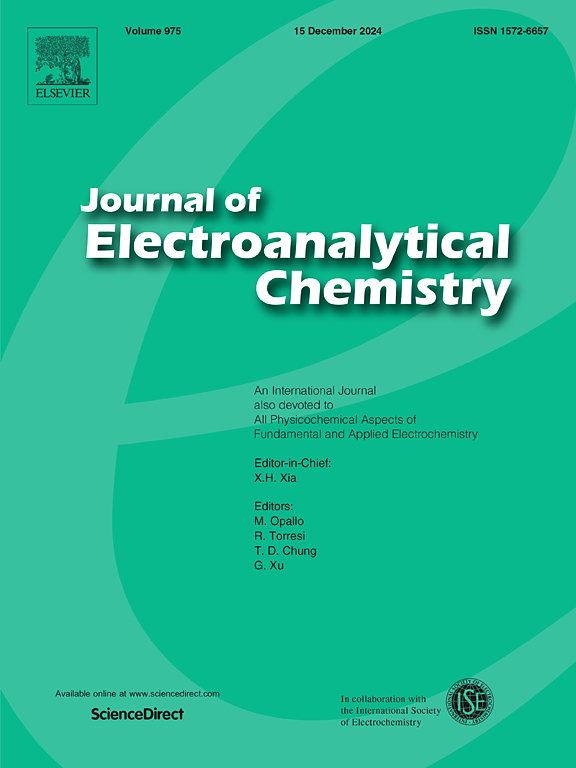直接和负担得起的电化学传感胶原质评估补充剂:一种新的策略羟脯氨酸定量
IF 4.1
3区 化学
Q1 CHEMISTRY, ANALYTICAL
引用次数: 0
摘要
羟脯氨酸(Hyp)是胶原蛋白含量最重要的生物标志物之一。它不仅对临床跟踪有用,而且对证明胶原蛋白膳食补充剂的质量也有用。由于胶原蛋白补充剂消费的日益普及,这项工作提出了一种新的方法来测定胶原蛋白含量的羟脯氨酸法。这项研究是第一份描述使用未经修饰的丝网印刷碳电极作为高效流线型传感器检测Hyp的报告,该研究的亮点在于无需复杂的制备和检测过程。测量依赖于Hyp的间接检测,通过比较在Hyp不存在和存在时Cu(II)离子的信号,在基本条件下使用样品和Cu(II)的顺序滴混合物。对方波阳极溶出伏安法(SWASV)检测的关键参数进行了系统的检验,以提高灵敏度和准确性。在最佳条件下,无修饰传感器具有良好的Hyp检测性能,线性范围为0.5 ~ 10 mM,检出限为0.15 mM。在实际分析中,胶原补充样品中Hyp的检测可接受回收率为80.36 ~ 107.89% (n = 3)。此外,将该方法的结果与常规标准技术进行了验证。配对t检验的置信水平为95%,表明两种方法之间没有显著差异。因此,该方法为食品质量安全控制中胶原蛋白的常规和实时分析提供了一种有前景的分析方法。本文章由计算机程序翻译,如有差异,请以英文原文为准。
Straightforward and affordable electrochemical sensing for collagen quality assessment in supplements: A novel strategy for hydroxyproline quantification
Hydroxyproline (Hyp) is one of the most significant biomarkers of collagen content. It is useful not only for clinical tracking but also for proving the quality of collagen-based dietary supplements. Due to the increasing popularity of collagen supplement consumption, this work presents a novel approach for the determination of collagen content using the hydroxyproline method. This study is the first report that describes the use of an unmodified screen-printed carbon electrode as an efficient and streamlined sensor for the detection of Hyp. The highlight of this research is eliminating any need for complicated preparation and detection processes. The measurement relies on the indirect detection of Hyp by comparing the signal of Cu(II) ions in the absence and presence of Hyp, using a sequential drop mixture of the sample and Cu(II) in a basic condition. Key parameters related to square wave anodic stripping voltammetry (SWASV) for detection were systematically examined to improve sensitivity and accuracy. Under optimal conditions, the modification-free sensor offers good performance for Hyp detection with a linear range of 0.5–10 mM and a detection limit of 0.15 mM. In practical analysis, Hyp in the collagen supplement samples was detected with an acceptable recovery range of 80.36–107.89 % (n = 3). In addition, the results obtained from the suggested approach were validated against the conventional standard technique. A paired t-test at the confidence level of 95 % shows no significant difference between the two methods. Therefore, this proposed method offers a promising assay for routine and real-time collagen analysis in food quality and safety control.
求助全文
通过发布文献求助,成功后即可免费获取论文全文。
去求助
来源期刊
CiteScore
7.80
自引率
6.70%
发文量
912
审稿时长
2.4 months
期刊介绍:
The Journal of Electroanalytical Chemistry is the foremost international journal devoted to the interdisciplinary subject of electrochemistry in all its aspects, theoretical as well as applied.
Electrochemistry is a wide ranging area that is in a state of continuous evolution. Rather than compiling a long list of topics covered by the Journal, the editors would like to draw particular attention to the key issues of novelty, topicality and quality. Papers should present new and interesting electrochemical science in a way that is accessible to the reader. The presentation and discussion should be at a level that is consistent with the international status of the Journal. Reports describing the application of well-established techniques to problems that are essentially technical will not be accepted. Similarly, papers that report observations but fail to provide adequate interpretation will be rejected by the Editors. Papers dealing with technical electrochemistry should be submitted to other specialist journals unless the authors can show that their work provides substantially new insights into electrochemical processes.

 求助内容:
求助内容: 应助结果提醒方式:
应助结果提醒方式:


